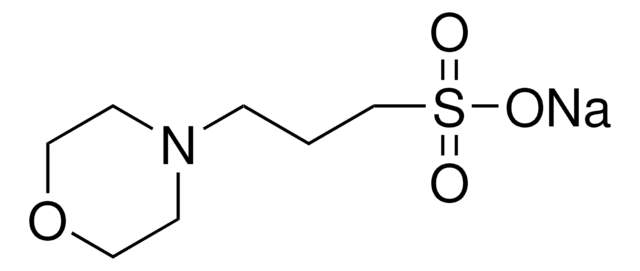RES6007H-A7
HEPES
Produzione farmaceutica
Sinonimo/i:
Acido 4-(2-idrossietil)piperazina-1-etansolfonico, N-(2-idrossietil)piperazina-N′-(acido 2-etansolfonico)
About This Item
Prodotti consigliati
Origine biologica
synthetic
Livello qualitativo
Forma fisica
powder
tecniche
cell culture | mammalian: suitable
Impurezze
Endotoxin, microbial, and trace metals; tested
Intervallo di pH utile
6.8-8.2
pKa (25 °C)
7.5
Compatibilità
suitable for manufacturing use
Attività estranea
Cytotoxicity, DNase, NICKase, RNase, and Protease; tested
Stringa SMILE
[Na+].OCCN1CCN(CC1)CCS([O-])(=O)=O
InChI
1S/C8H18N2O4S.Na/c11-7-5-9-1-3-10(4-2-9)6-8-15(12,13)14;/h11H,1-8H2,(H,12,13,14);/q;+1/p-1
RDZTWEVXRGYCFV-UHFFFAOYSA-M
Cerchi prodotti simili? Visita Guida al confronto tra prodotti
Descrizione generale
M-Clarity Program
Buffer quality is vital for the success of biopharmaceutical processes, because buffers are indispensable in nearly every production step.
Our broad portfolio of buffer materials manufactured under appropriate controls is tailored to your needs. Ranging from non-GMP grades for low-risk application, to IPEC-PQG GMP for higher-risk applications, we have products covering all your manufacturing needs.
Applicazioni
HEPES Sodium is used in cell culture media, biopharmaceutical buffer formulations (both upstream and downstream) and diagnostic reagent formulations.
Confezionamento
RES6007H-A701X: 100g container
RES6007H-A702X: 1kg container
RES6007H-A704X: 10kg container
RES6007H-A705X: 25kg container
Note legali
Sostituito da
Codice della classe di stoccaggio
11 - Combustible Solids
Classe di pericolosità dell'acqua (WGK)
WGK 3
Punto d’infiammabilità (°F)
Not applicable
Punto d’infiammabilità (°C)
Not applicable
Certificati d'analisi (COA)
Cerca il Certificati d'analisi (COA) digitando il numero di lotto/batch corrispondente. I numeri di lotto o di batch sono stampati sull'etichetta dei prodotti dopo la parola ‘Lotto’ o ‘Batch’.
Possiedi già questo prodotto?
I documenti relativi ai prodotti acquistati recentemente sono disponibili nell’Archivio dei documenti.
I clienti hanno visto anche
Il team dei nostri ricercatori vanta grande esperienza in tutte le aree della ricerca quali Life Science, scienza dei materiali, sintesi chimica, cromatografia, discipline analitiche, ecc..
Contatta l'Assistenza Tecnica.



